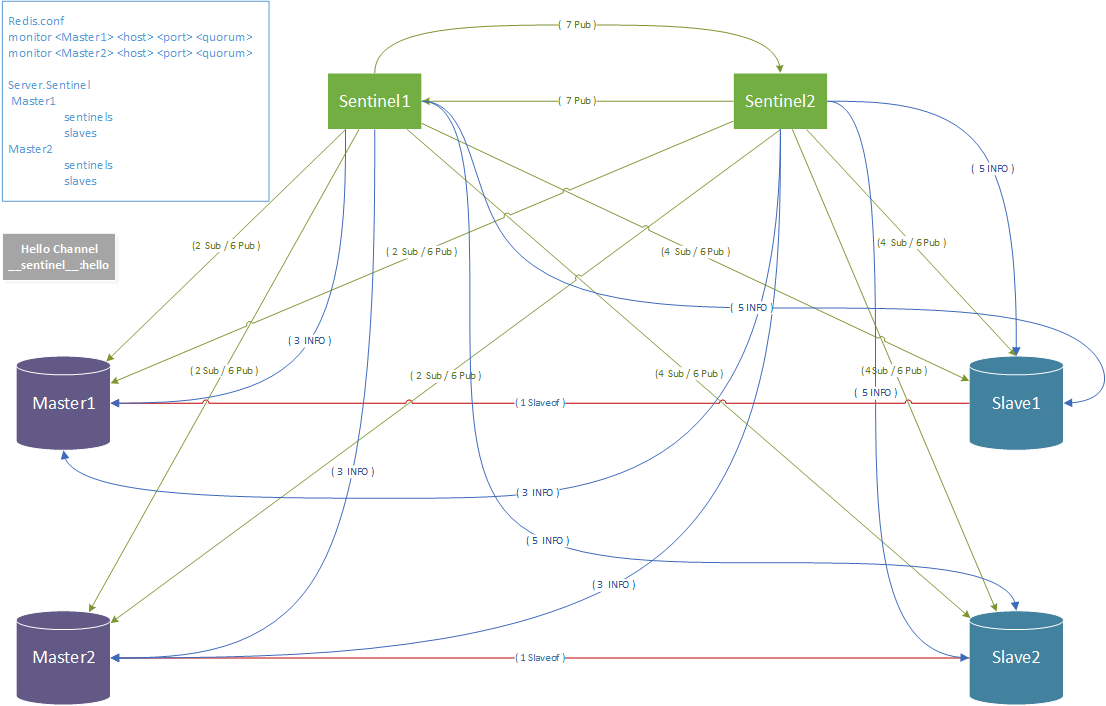Redis Sentinel 通信流程
准备工作:
1. 配置 master slave 、修改sentinel 配置,如下:Redis.conf monitor <Master1> <host> <port> <quorum> monitor <Master2> <host> <port> <quorum>2. 启动 master / slave 节点,然后再启动 sentinel 节点
通信流程:
定时器会逐层遍历sentinel结构,轮询执行下面的主流程,最初,整个节点只有masters 信息,根据不断的扩散,逐渐完善整个结构,最终形成一张非常复杂环形网络。下面的每个命令都有一个执行频次,未到指定周期不会执行,进而执行之后的命令。节点结构:
sentinel masters Master1 sentinels sentinel1 sentinel2 slaves slave1 slave2 Master2 sentinels ... slaves ...
主流程:
1. sentinelReconnectInstance 建立连接
connect - Commands connection (建立普通连接,用于后续发送 PING INFO PUBLISH 等命令)
connect - Pub/Sub connection(建立订阅连接,用户持续接受其他节点发来的消息)
subscribe(发送订阅命令,等待接收消息)
2. sentinelSendPeriodicCommands 发送周期性命令
send info - (向Master/Slave 发送 Info 命令,获取主从关系、服务器健康状况信息),正常频率为每 10s 执行一次
send ping - sentinelSendPing(向Sentinel/Master/Slave 发送 ping 命令,心跳检测,根据是否及时回应消息来判断节点是否健康,用于故障监测),正常频率为每 1s 执行一次
send hello - sentinelSendHello(向Sentinel/Master/Slave 发送 publish 命令,通过共同订阅同一个Master的消息队列使得多个Sentinel 可以相互连接),正常频率为每 2s 执行一次
详细流程:(省略ping过程,这里只关注多个节点如何传播与扩散)
1. slaveof 主从连接2. sentinel 向Master 发送 SUBSCRIBE 命令,订阅 Master 的 Hello Channel (SUBSCRIBE __sentinel__:hello),等待接收消息
3. sentinel 向 Master 发送 INFO 命令,获取服务信息,及发现主从关系(获取到 Slave 信息)
4. sentinel 向 Master/Slave 发送 SUBSCRIBE 命令,与 2 类似(这次有了Slave节点)。如果之前已有的连接正常,则不会再次重复连接,因此正常情况下这一步只会连接新加入的Slave节点。
5. sentinel 向 Master/Slave 发送INFO命令,与 3 类似。
6. sentinel 向 Master/Slave 发送PUBLISH命令,扩散消息(当前Sentinel/Master 信息 )。sentinel 接收到了 Master/Slave 中 Hello Channel 中的消息,得到其他的Sentinel 信息,然后保存到对应Master 下的 Sentinels 列表中。至此,整个 sentinel 结构中的节点数据基本完善。
7. sentinel 向 Master/Slave/Sentinel 发送 PUBLISH命令,扩散消息。
在经过多次的消息扩散之后,每个 master 下的 sentinels 列表会逐渐增多。最终,每个 sentinel 中将保存着所有 Sentinel/Master/Slave 信息,并且不断进行心跳监测,信息同步。
上面这7步执行过程如下图:

总结
1. 集群中节点有3种角色,分别是 Sentinel/Master/Slave。Master 、Slave 就是普通的RedisServer,而Sentinel与他们不同,客户端不能直接进行get set inc hset hlen 等命令操作。它的作用是如果Master节点发生故障后,选取该Master对应的其中一个Slave提升会Master,客户端通过订阅 Sentinel 的变更消息来获取到这个事件,进而连接新的Master IP,以达到最快的时间恢复对外服务的能力,提升可用性。
2. 在各个节点通信中,只有Sentinel 会向 Sentinel/Master/Slave 主动发出 RPC 请求,可以说是单向的。Master、Slave 还是普通的RedisServer,因此他们不会有别的行为。如果Sentinel发送Ping ,他们就回复 Pong;如果Sentinel发送Info,他们就回复对应的服务器信息;如果Sentinel发送Subscrib/Publish命令,他们执行对应的处理。只是把Sentinel节点当做普通的客户端来看待,不会有任何额外的关于Sentinel的偏袒。
3. Sentinle -> 其他Sentinel 有3种RPC,Sentinel ->Master/Slave 有4种类型RPC。Sentinel -> Sentinel 的3个RPC 分别是 Ping/Publish/Vote。Sentinel -> Master/Slave的RPC分别是Ping/Info/Subscrib/Publish。
Ping 也称为 Heartbeat RPC,用来检测各个节点的存活情况与延时,根据回复Pong的时长进行判断,如果超过设定的超时时间,该Sentinel标记这个节点为 SRI_S_DOWN(主观下线)。
Info RPC 用来只发送给Master/Slave,用来获取这些信息
a) run_id 节点id,如果重启会变更,则对应在Sentinel中登记的名称也修改为新值
b) Master/Slave信息,包括当前节点角色,是Master,还是Slave,还有每种情况对应的与之关联的Slave/Master节点IP/PORT信息。用来根据Master发现Slave,根据Slave发现Master,还包括Master / Slave 角色切换的情况。有了这一步,我们在启动Sentinel的时候只需要在配置文件中配置Master IP/PORT 就行,它会根据这个机制自动找到Slave节点。具体如下:
run_id:<40 hex chars> master_link_down_since_seconds:<seconds> role:<role> Master Node: slave0:<ip>,<port>,<state> /* old versions*/ slave0:ip=127.0.0.1,port=9999,... /* new versions*/ Slave Node: master_host:<host> master_port:<port> master_link_status:<status> slave_priority:<priority> slave_repl_offset:<offset>Publish RPC 用来发送当前Sentinel 信息与其对应的Master信息。作用:①传播当前Sentinel 与其连接的Master,让其他Sentinel节点也发现这些节点;②如果当前Sentinel 与其对应的Master信息有变更,则通知其他Sentinel节点,比如故障转移之后,原来的Master变为Slave,其中的一个Slave则变为了Master。
Message: <ip>,<port>,<runid>,<current_epoch> <master_name>,<master_ip>,<master_port>,<master_config_epoch>Subscrib RPC 是Sentinel订阅 Master/Slave节点的 Hello Channel(__sentinel__:hello) 。通过这个Channel来接收上一步的Publish 消息。这个只应用于 Master/Slave 节点,Sentinel -> Sentinel 是直接通过 Publish 命令进行直接处理,不经过任何Channel。
Vote RPC 是当Sentinel发现Master发生故障,即达到主观下线状态(SRI_S_DOWN),向所有Sentinel节点确认是否真的是发生故障。如果大多数节点认为该Master确实是发生故障,则当前Sentinel 设置该Master为客观下线状态(SRI_O_DOWN)。通过发送Sentinel命令来实现,这个是发送给Sentinel节点。
SENTINEL IS-MASTER-DOWN-BY-ADDR <ip> <port> <current-epoch> <runid>
上面的这个命令有2种使用场景,第一,runid为*,如果 Master 处在主观下线状态(SRI_S_DOWN),则当前Sentinel节点定期给其他Sentinel节点发送这个命令,然后计算收到 SRI_MASTER_DOWN 的票数(节点数),如果大于指定票数,那么就标记这个节点为客观下线状态(SRI_O_DOWN)。第二,runid为当前Sentinel节点的id,如果Master处在客观下线状态,则进行投票请求,目的是选举一个 leader来执行本次故障转移。
4. 几种RPC,各自都有自己的执行频次与超时时间,有的是先后依次执行,有的是在下一个时间周期执行,因此他们的执行顺序不好明确说明。
疑问:
1. Sentinel之间传递消息可以直接发送命令(PUBLISH),为什么还要使用Master/Slave的Channel来进行通信?
在Sentinel启动时,我们在配置文件中并没有指定其他Sentinel信息,因此这是他们还是单点,无法形成集群,也就无法进行后续的投票等操作。只有通过每个Sentinel都订阅其共同的Master/Slave 来达到发现其他Sentinel的目的。
如果有任何不正确的地方,请指正,谢谢!

Thank you! Excellent information.
您好,sentinel在向的Master/Slave 发送消息的时候,是要向每个master或者slave全部发一遍同样的消息么,还是只是发送一部分节点就好
你好,请问sentinel有给_sentinel_:hello频道发送消息,但是好像没有去取得其他sentinel存在的信息,是需要另外的配置么,我的sentinel客户端所在的虚拟机可以连上其他虚拟机的sentinel服务端,也没有进行其他关键配置更改,你知道是什么原因么
不好意思,这么久才看到你的回复。现在问题是否已经解决呢?
每个sentinel 节点的配置文件中加入 monitor 指令就行了,如上准备工作中提到的。为了方便管理,通常各个sentinel配置的monitor 指令后面的ip / port 与其他参数都相同。
你这种情况是不是对应的master节点不同?